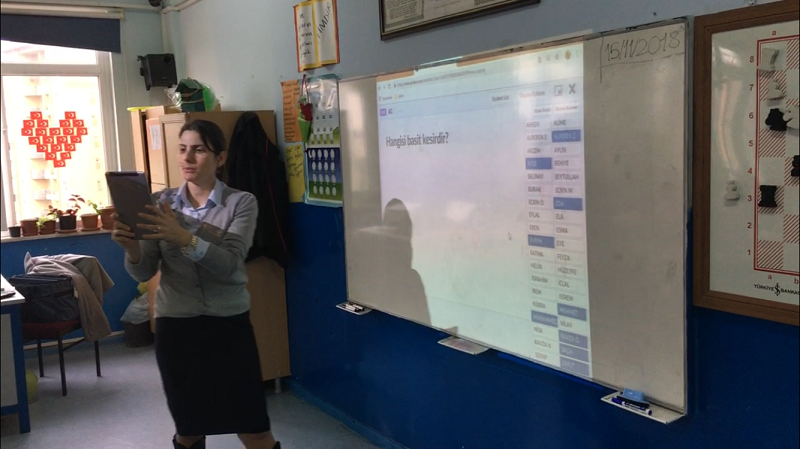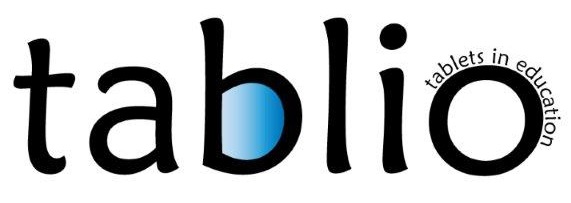Mobile Apps for Teaching Math in Primary School

Teacher Design Team
TABLIO Project Istanbul team prepared a Teacher Design Team consisting of 1 math teacher, 1 pre-service teachers from Istanbul University – Cerrahpaşa, and 2 teacher trainers for Ümraniye Nurettin Topçu Primary School. The 1 teacher from this school was invited to the Faculty of Education at Istanbul University – Cerrahpaşa. The teacher was invited for 4 weeks and the previous TDT design was used. During the meetings first the pedagogical approach of TABLIO project was presented by the teacher trainers, then the concept map and the concept of differentiation was introduced. Next sessions included the school presentation and the context and needs of the schools as well as the centralized curriculum that the school followed. Then the curriculum of the school for 4th grade was transformed for differentiation with tablets and many apps were matched to the learning outcomes. The teachers preferred to create their own lesson plan that was in parallel with the centralized curriculum. The teacher came up with their lesson plans and good practices in the end of the 1 month they had for application.
The school Ümraniye Nurettin Topçu İlkokulu was established in 2005 - 2006 Academic Year. In 2005, it was constructed as 1 manager room, 3 deputy director rooms, 24 classrooms, 3 science laboratories, 1 visual arts classroom, 1 computer technology class and 1 multi-purpose hall. However, the school has been transformed into primary school in the academic year of 2012-2013 and there are currently 1 manager room, 2 assistant manager rooms, 42 classrooms (private education and classroom for Syrian students), 2 guidance rooms and 1 multi-purpose hall. The school has 3 floors excluding basement and ground floor. The school was named as Dudullu Primary School and changed to Nurettin Topçu Primary School since December 2015. The school is a regular state school (full-time education from 8.50-14.20).
Mobile Apps for Math Lesson
The lesson was planned for the Math class for 39 students from the class 4, section G. The Primary school Math teacher Aysegul Rendeci Yumurtaci has prepared a lesson plan to differentiate her “Types of Fractions” unit, she used the tablets to differentiate the process and product.


Challenges
Math teacher Aysegul Rendeci Yumurtaci’s report on challenges and advantages of using tablets in her class:
- Activities should not be started before the students and parents are informed about the virtual / digital environments. The programs required for the application should be pre-loaded on the tablets. Digital netiquette rules should be explained. Online activities should be prepared according to the students’ achievements. More than one event must be prepared for each learning outcome. The same activity pushes towards memorization.
- There are no smart boards in our class.
- No connection to FATIH project.
- At the same time, the connection of all tablets to the network of the school was not possible.
- Tablets can be connected with outside facility. An average of 4 students per tablet were assigned.
- Individual work could not be done in class (except Plickers).
- Some programs/apps should be updated from time to time, otherwise the running program can be installed in the class.
- The memory or versions of the tablets were inadequate.
- Because of the shortage of applications in the application, we focused on tablet applications usable without internet.
- Because of the shortage of the internet network, individual-purpose activities are usually given as homework (kahoot, learningapps).
- The teacher should prepare and experiment before the class.
- One error can take 40 minutes of the class.
- Changes should be made within the group. Sometimes, some students may become dominant in groups. The teacher should observe all the time.
Advantages
- The students and parents trust the teacher.
- The parents support the activities with preliminary information given about the applications.
- The students forget to go to the break when they are engaged with the tablet.
- Synergies occur in working groups.
- Applications without internet are suitable for small age students and group because they are closed to online dangers.
- A fast and different learning environment is formed.
- There is a transition from concrete to abstract.
- Mobile learning allows learning anywhere anytime.
- Activities are creating a permanent archive.
- Prepared activities can also be reached on students’ holidays.
- Studies affect visual intelligence.
- Activities suitable for creating student level groups open the way for learning. (difficult, easy, intermediate questions)
- There are activities suitable for individual and group work.
- At the end of the activities, the student expects an appreciation or a movement from his / her teacher.
- Foreign language vocabulary knowledge is increasing in applications (play, stop continue, upgrade, resume, fraction etc.)
- The virtual media are developing digital literacy.
- Students are aware of the fact that this type of work exists instead of just time-killing games that are empty and violent.
- Competitive spirit is developing.
- Students enjoy their own practice.
- They learn ways to enrich their homework.
Design
The teacher used many apps on her tablet to start the lesson and then to end the lesson, for example “Learningapps”, “kahoot”, “plickers”, “padlet”, “cram”, “quiver”, “tagul”, “toontastic”, “scratch”, “hp reveal”, “inigma”, “calmfash”, “canva”, “classDojo”, “Animoto”, “kligtag”.
Implementation and Evaluation
The teacher started her lesson by asking students to classify the types of fractions on their tablets on LearningApps and observed while the students did the activity in groups. Then she asked her students to answer questions about fractions with plickers app. Then she scanned her students answers and reflected on the screen, then she evaluated that 23 students answered correctly and so on.


Conclusion
Our TDT revealed many sides to the using tablets for differentiation in classrooms. We observed that the teachers appreciated the fact that their voice was valued in the design of an idea. However, due to unexpected events one of the TDTs had to be completed without an actual result. Although they had many resources and were really prepared to execute an in-class activity, the school closed down and the teachers had to be replaced. The second school, which was a state school with fewer resources and deficiency in many aspects could complete the tasks and succeeded after the TDT. All of the activities in this TDT have been successfully recorded on videos and thus reported. The teachers who undertook the activities created video reports as well as reports on their progress based on the TDT. Our experience came across challenges such as crowded classes, scarcity in resources and number of tablets per student, issues with reliable internet connection, the cost of apps, time consumption of the planning process and logistics for tablets. On the other hand, students enjoyed the lessons with tablets and their motivation increased, the teachers felt refreshed and reported positive attitude of the students.
